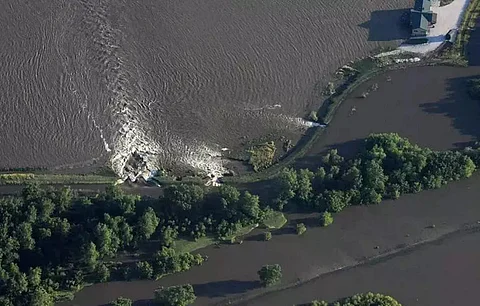
- Home
- Live Blog
- Breaking News
- Top Headlines
- Cities
- NE News
- Sentinel Media
- Sports
- Education
- Jobs

NEW DELHI: The total number of climate change court cases has more than doubled since 2017 and is growing worldwide, a new report has revealed. The report, Global Climate Litigation Report: 2023 Status Review, published by the UN Environment Programme (UNEP) and the Sabin Center for Climate Change Law at Columbia University ,show that climate litigation is becoming an integral part of securing climate action and justice.
It is based on a review of cases focused on climate change law, policy or science collected up to December 31, 2022 by the Sabin Center’s US and Global Climate Change Litigation Databases.
It was published a day ahead of the first anniversary of the UN General Assembly’s declaration of access to a clean and healthy environment as a universal human right.
“Climate policies are far behind what is needed to keep global temperatures below the 1.5 degrees Celsius threshold, with extreme weather events and searing heat already baking our planet,” said Inger Andersen, Executive Director of UNEP.
“People are increasingly turning to courts to combat the climate crisis, holding governments and the private sec-tor accountable and making litigation a key mechanism for securing climate action and promoting climate justice.”
The report provides an overview of key climate litigation cases from the past two years, including historic break-throughs.
As climate litigation increases in frequency and volume, the body of legal precedent grows, forming an increas-ingly well-defined field of law.
The total number of climate change cases has more than doubled since a first report on the issue, from 884 in 2017 to 2,180 in 2022.
While most cases have been brought in the US, climate litigation is taking root all over the world, with about 17 per cent of cases now being reported in developing countries, including Small Island Developing States.
These legal actions were brought in 65 bodies worldwide: in international, regional, and national courts, tribu-nals, quasi-judicial bodies, and other adjudicatory bodies, including special procedures of the UN and arbitration tribunals.
“There is a distressingly growing gap between the level of greenhouse gas reductions the world needs to achieve in order to meet its temperature targets, and the actions that governments are actually taking to lower emissions. This inevitably will lead more people to resort to the courts. The report will be an invaluable resource for everyone who wants to achieve the best possible outcome in judicial forums, and to understand what is and is not possible there,” said Michael Gerrard, Sabin Center’s Faculty Director. The report demonstrates how the voices of vulnerable groups are being heard globally: 34 cases have been brought by and on behalf of children and youth under 25 years old, including by girls as young as seven and nine years of age in Pakistan and India respectively, while in Switzer-land, plaintiffs are making their case based on the disproportionate impact of climate change on senior women.
Notable cases have challenged government decisions based on a project’s inconsistency with the goals of the Paris Agreement or a country’s net-zero commitments.
Growing awareness of climate change in recent years has also spurred action against corporations — these in-clude cases seeking to hold fossil fuel companies and other greenhouse gas emitters responsible for climate harm. According to the report, most ongoing climate litigation falls into one or more of six categories: First, cases relying on human rights enshrined in international law and national constitutions; Second, challenges to domestic non-enforcement of climate-related laws and policies; Third, litigants seeking to keep fossil fuels in the ground; Fourth, advocates for greater climate disclosures and an end to greenwashing; Fifth, claims addressing corporate liability and responsibility for climate harms; and Sixth, claims addressing failures to adapt to the impacts of climate change.
The report demonstrates how courts are finding strong human rights linkages to climate change. This is leading to greater protections for the most vulnerable groups in society, as well as increased accountability, transparency and justice, compelling governments and corporations to pursue more ambitious climate change mitigation and adaptation goals.
In the future, the report predicts a rise in the number of cases dealing with climate migration, cases brought by Indigenous peoples, local communities and other groups disproportionately affected by climate change, and cases addressing liability following extreme weather events. The report also anticipates challenges in applying the science of climate attribution as well as a rise in “backlash” cases against litigants which aim to dismantle regulations that promote climate action. (IANS)
Also Watch: